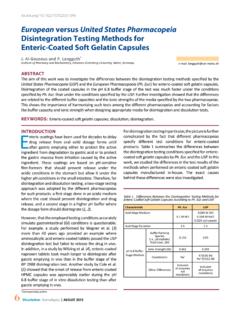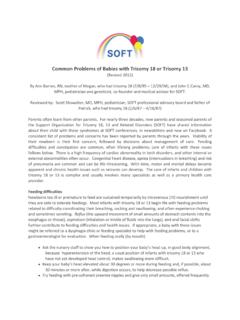Transcription of The future of underwriting - EY
1 The future of underwritingA transformation driven by talent and technology1| The future of underwriting A transformation driven by talent and technology2 The future of underwriting A transformation driven by talent and technology |As insurers look at large-scale and transformative investments in their front-office capabilities, many are turning their attention to underwriting . Specifically, there is widespread consensus that the role of this central function can and must significantly change if insurers are to modernize their operations and infrastructure to meet rising agent, business owner and consumer expectations. This is a historic shift, as underwriting , once considered the very heart of the insurance business, has an opportunity to define its future and regain its central place in the insurance enterprise. Further, underwriting leaders can reposition themselves as higher-profile strategic influencers and decision-makers, roles they have traditionally played, but in which they have lost ground in recent decades.
2 Within the function, the focus will shift away from internal processes and specific transactions (where underwriters have historically invested their time and energy) and emphatically toward market-facing relationships and sales (around which insurers of all types are re-orienting operations). In this sense, future underwriters will become masters of many trades, with a broader portfolio of accountabilities and involvement in more customer-facing processes than they A recent history of u nderw ritingTraditionally, underwriting has been the heart of the insurance business. A case can be made that underwriting is synonymous with the insurance business itself. The industry would simply not exist without the ability to evaluate and accept risk and price and issue policies. It is no wonder, then, that many past industry notables and company executives came up through the ranks of underwriting . As recently as the 1980s, underwriters were viewed as clear leaders, the people whose responsibility it was to put the surplus on the line and define the company in the recent decades, the path to the insurance C-suite has more commonly run through finance, with significant talent imported from other financial services sectors.
3 The financial areas of the company have risen to greater visibility and power, while the management profile of underwriting has dipped noticeably. On a practical level, finance steadily broadened its scope by becoming more engaged with planning, analysis and strategic decision making across the enterprise. underwriting , by contrast, seemed to narrow its focus to binary transactional processing and cling to the art of the decision-making process. The increasing use of quantifiable metrics and data-driven decision making has been one by-product of this the same time, profound technological advancements especially the advent of predictive modeling have changed the rules of the game within underwriting . Simple, binary logic for knockout scoring, which was first used for auto policies, was followed by modeling and automated evaluations for homeowners policies and, to a more limited extent, small commercial lines. Next came more robust analysis and sophisticated risk-profiling techniques, such as pattern matching.
4 Stronger rules and predictive modeling became so prevalent during the last 5 to 10 years (especially in personal and small commercial lines) that many began to ask if human underwriters would be replaced altogether. By contrast, the middle market and larger commercial sectors, which have been largely neglected and left behind in this technology revolution, are poised to benefit from robust underwriting workstation solutions now available in the where does that leave us today? And what is the path forward? Powerful new technologies have automated many of the relatively low-value transaction processing tasks so that underwriters are free to take on higher-value relationship building and analytical work. underwriting can and should also more effectively support and engage with the full market-facing ecosystem of insurance operations. Underwriters can add value at every phase and interaction in the account relationship by helping to facilitate sales, for instance, or strengthening existing relationships through creative servicing enhancements.
5 Looking ahead, it s clear that their unique organizational position makes underwriters naturally suited to leadership roles within the modern insurance enterprise. They can serve as quarterbacks for the organization, coordinating between different functions to ensure that the right accounts are well looked after and emerging risks appropriately managed within a customer life cycle. The opportunity for underwriters to reclaim a leadership role reflects their involvement in and ability to positively influence so many essential tasks. More practically, insurers must prepare to deal with an emerging underwriting talent gap, as many experienced workers face retirement in the next several years. The increasing investment in underwriting technology is a positive development to help institutionalize knowledge, but the talent impact cannot be overlooked. The optimal return on investment will come through the combination of greater analytical and computing firepower plus nuanced understanding of market risks and opportunities, and the strategic coordination of both front-office and back-office activities in line with market goals.
6 That s especially true because underwriters are exceptionally well placed to synchronize and guide cross-functional efforts in line with specific customer-related today. The changes are being felt most acutely in the small commercial area, though they are influencing the full range of insurance segments. Increased automation and stronger analytical capabilities are a big part of the story, especially as they liberate underwriters to spend more time on higher-value activities, such as account planning, solution development, agent partnering, and nuanced risk assessment and decision-making. Beyond big data and analytics, however, other powerful technologies including sensors, telematics, location-based services, semantic web and mobile promise to dramatically change the way underwriters work and expand the ways they can contribute value to the thought leaders in the space also view refined skills and new talent as essential variables in the equation for future market success.
7 To some extent, this is an effect of an aging workforce. The insurers that make the most of this evolution will be those that don t neglect or overlook the organizational change management and human dimensions of underwriting transformation. That is, the carriers that can identify the future skills necessary to harness the potential of enabling technologies, and develop the next generation of underwriting talent will give themselves a sustainable edge in realizing the value of their strategic investments in change. This paper presents a vision for the future of underwriting . More precisely, it describes the role that underwriters will play in the coming years, while also providing a historical context for the evolution of underwriting , and outlines new ways that underwriters will interact with both internal and external constituencies and stakeholders. Lastly, it highlights some of the transformative technologies and talents that insurers will need to thrive in tomorrow s highly dynamic and competitive summary3| The future of underwriting A transformation driven by talent and technology4 The future of underwriting A transformation driven by talent and technology |R ethink ing the p ossibilitiesA clear case can be made that tomorrow s top performers in the insurance industry will have underwriters who play considerably different and higher-value roles than those they play today.
8 In fact, future underwriters will often act in ways that resemble other roles. Those roles include: Sales executive Decision scientist Customer advocate InnovatorA multitude of emerging technologies will enable new capabilities across these roles and take on greater importance in the day-to-day life of underwriters. The common denominator for technologies as diverse as sensor-based technologies and semantic web applications is their ability to feed a process of insight generation, as opposed to simple data aggregation or collection, as seen in the examples below. A widening range of models will become go-to tools for underwriters. As they assume these new roles, underwriters will succeed as they gain the ability to use new data sources and interfaces to identify important trends, new areas for analysis, and emerging opportunities and risks. Further, communications patterns will shift; more outreach, information sharing and collaboration will take place via social media and/or mobile channels.
9 That s true for both customer communications and for engaging with agents, distributors and internal colleagues. U nderw riter as sales ex ecu tiveIt is not difficult to envision how underwriters can leverage their access to information and big picture views of desirable customer types to contribute significant value to the sales process. For example, the perspective of skilled underwriters could improve the quality of lead identification and qualification processes, in that underwriters are well positioned to understand the specific characteristics that mark a good lead. The same insights are useful in shaping promotional campaigns and playbooks for cross-selling, up-selling and account retention programs. In other words, underwriters have expertise that can be applied across the continuum throughout the sales and account servicing life underwriters take on new responsibilities, their performance will be assessed in ways that go beyond conventional measures (such as hit and retention ratios, annualized growth and calendar year and accident year loss ratios) to include more sophisticated sales, service and portfolio metrics.
10 In such a world, underwriters may seek to develop personal brands, and differentiate themselves by, for instance, making themselves accessible anywhere, anytime and through any device, or by publishing value-added content for both potential policyholders and agents. Looking at the enabling technology, underwriters will rely on integrated marketing and sales platforms (see callout), referencing both internal and external data such as real-time news feeds, social media updates and research. Semantic web technology will apply rules to aggregated data to synthesize and filter the most relevant information and events and minimize the risk of overwhelming users with data. Collaboration will take place through personalized and shared meeting spaces for agents and brokers, underwriters and others. Trends in sales pursuits can be assessed to identify patterns and apply similar criteria to other opportunity areas; benchmarks around risk attributes can be evaluated and leveraged for better pricing da y in the l ife of the future s a l es ex ec utiv e- underwriter Visits integrated marketing and campaign management portal to identify sales opportunities Reviews the results of marketing campaign, targeting specific customer and geographic profiles, and finds a higher success rate for a particular type of account ( , industry, program, product)















